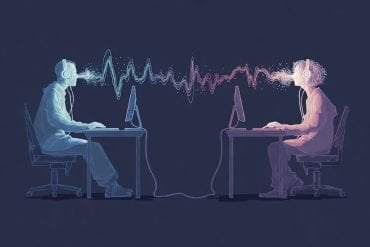Summary: A new Frontiers in Psychology study reveals many teachers believe in common misconceptions about learning and the brain. Researchers say they are considering creating an online training scheme aimed at educators to help dispel such neuromyths.
Source: Frontiers.
A survey has shown that many educators, and even those with neuroscience training, believe in neuromyths — common misconceptions about the brain and learning.
Researchers have surveyed educators, the public and people who have completed neuroscience courses, to assess their belief in neuromyths. Neuromyths are common misconceptions about brain research, many of which relate to learning and education. They found that belief in neuromyths is extremely common and that training in education and neuroscience helped to reduce these beliefs, but did not eliminate them.
Would you rate the following statement as ‘True’ or ‘False’? “A common sign of dyslexia is seeing letters backwards.” If you chose ‘True’ then you are in good company – 76% of the public, 59% of educators and 50% of people who have completed neuroscience courses agree with you. The problem is, the statement is false. It’s a neuromyth, and a recent study published in Frontiers in Psychology has shown that these misconceptions are incredibly common.
So, why does it matter if people believe in neuromyths? Many neuromyths relate brain research to education, but misinterpret or overstate the original research. They are often oversimplifications, reducing complex issues to just one factor, such as “kids are less attentive after eating sugary snacks”.
For teachers who believe the dyslexia neuromyth above, they might miss an opportunity to get a child with dyslexia appropriate help, if the child doesn’t display letter reversals. Similarly, teachers using educational techniques based on neuromyths may achieve better results by switching to evidence-based methods.
While previous research has shown that belief in neuromyths is worryingly common in other countries, there was little known about this problem in US educators. Kelly Macdonald, a graduate student at the University of Houston involved in the study, had previously worked as a teacher. “I encountered neuromyths throughout teacher trainings and saw many teachers using related practices in their classrooms,” she says.
Macdonald and her colleagues investigated the prevalence of neuromyths in US educators using an online survey where respondents chose ‘True’ or ‘False’ for a series of questions about common neuromyths (for the full list check out the study). They also surveyed the public and people who had studied neuroscience, to see if training in education or neuroscience had any effect on neuromyth beliefs.
The survey revealed that neuromyth beliefs are remarkably prevalent, but that training in education and neuroscience helped to reduce these false beliefs. The public believed 68% of the neuromyths, educators 56%, and surprisingly, respondents with neuroscience training endorsed 46%.
“We were surprised at the level of neuromyth endorsement from respondents with neuroscience experience,” says Lauren McGrath, an Assistant Professor at the University of Denver who led the research study. “However, the myths they believed were related to learning and behavior, and not the brain. So, their training in neuroscience doesn’t necessarily translate to topics in psychology or education.”

What myths did respondents most commonly believe? The most commonly endorsed myth was “individuals learn better when they receive information in their preferred learning style”. Other common myths were related to the Mozart effect, dyslexia, using 10% of the brain, how sugar affects attention, and the role of the left and right hemispheres in learning. “We were surprised to see that these ‘classic’ neuromyths tend to cluster together, meaning that if you believe one myth, you are more likely to believe others,” explained McGrath.
So, how can we dispel these neuromyths and encourage evidence-based educational practices? “The next steps are to develop training and dissemination approaches,” explains McGrath. “We are considering an online training module for educators to dispel the most prevalent neuromyths. The fact that people tend to believe several myths means that training modules can’t just teach about a single myth, they need to address several simultaneously.”
Source: Melissa Cochrane – Frontiers
Image Source: NeuroscienceNews.com image is in the public domain.
Original Research: Abstract for “Dispelling the myth: Training in education or neuroscience decreases but does not eliminate beliefs in neuromyths” by Kelly Macdonald, Laura Germine, Alida Anderson, Joanna Christodoulou, and Lauren M. McGrath in Frontiers in Psychology. Published online August 8 2017 doi:10.3389/fpsyg.2017.01314
[cbtabs][cbtab title=”MLA”]Frontiers “Belief in Neuromyths is Extremely Common.” NeuroscienceNews. NeuroscienceNews, 10 August 2017.
<https://neurosciencenews.com/neuromyth-belief-7273/>.[/cbtab][cbtab title=”APA”]Frontiers (2017, August 10). Belief in Neuromyths is Extremely Common. NeuroscienceNew. Retrieved August 10, 2017 from https://neurosciencenews.com/neuromyth-belief-7273/[/cbtab][cbtab title=”Chicago”]Frontiers “Belief in Neuromyths is Extremely Common.” https://neurosciencenews.com/neuromyth-belief-7273/ (accessed August 10, 2017).[/cbtab][/cbtabs]
Abstract
Dispelling the myth: Training in education or neuroscience decreases but does not eliminate beliefs in neuromyths
Neuromyths are misconceptions about brain research and its application to education and learning. Previous research has shown that these myths may be quite pervasive among educators, but less is known about how these rates compare to the general public or to individuals who have more exposure to neuroscience. This study is the first to use a large sample from the United States to compare the prevalence and predictors of neuromyths among educators, the general public, and individuals with high neuroscience exposure. Neuromyth survey responses and demographics were gathered via an online survey hosted at TestMyBrain.org. We compared performance among the three groups of interest: educators (N=598), high neuroscience exposure (N=234), and the general public (N=3045) and analyzed predictors of individual differences in neuromyths performance. In an exploratory factor analysis, we found that a core group of 7 “classic” neuromyths factored together (items related to learning styles, dyslexia, the Mozart effect, the impact of sugar on attention, right-brain/left-brain learners, and using 10% of the brain). The general public endorsed the greatest number of neuromyths (M=68%), with significantly fewer endorsed by educators (M=56%), and still fewer endorsed by the high neuroscience exposure group (M=46%). The two most commonly endorsed neuromyths across all groups were related to learning styles and dyslexia. More accurate performance on neuromyths was predicted by age (being younger), education (having a graduate degree), exposure to neuroscience courses, and exposure to peer-reviewed science. These findings suggest that training in education and neuroscience can help reduce but does not eliminate belief in neuromyths. We discuss the possible underlying roots of the most prevalent neuromyths and implications for classroom practice. These empirical results can be useful for developing comprehensive training modules for educators that target general misconceptions about the brain and learning.
“Dispelling the myth: Training in education or neuroscience decreases but does not eliminate beliefs in neuromyths” by Kelly Macdonald, Laura Germine, Alida Anderson, Joanna Christodoulou, and Lauren M. McGrath in Frontiers in Psychology. Published online August 8 2017 doi:10.3389/fpsyg.2017.01314







